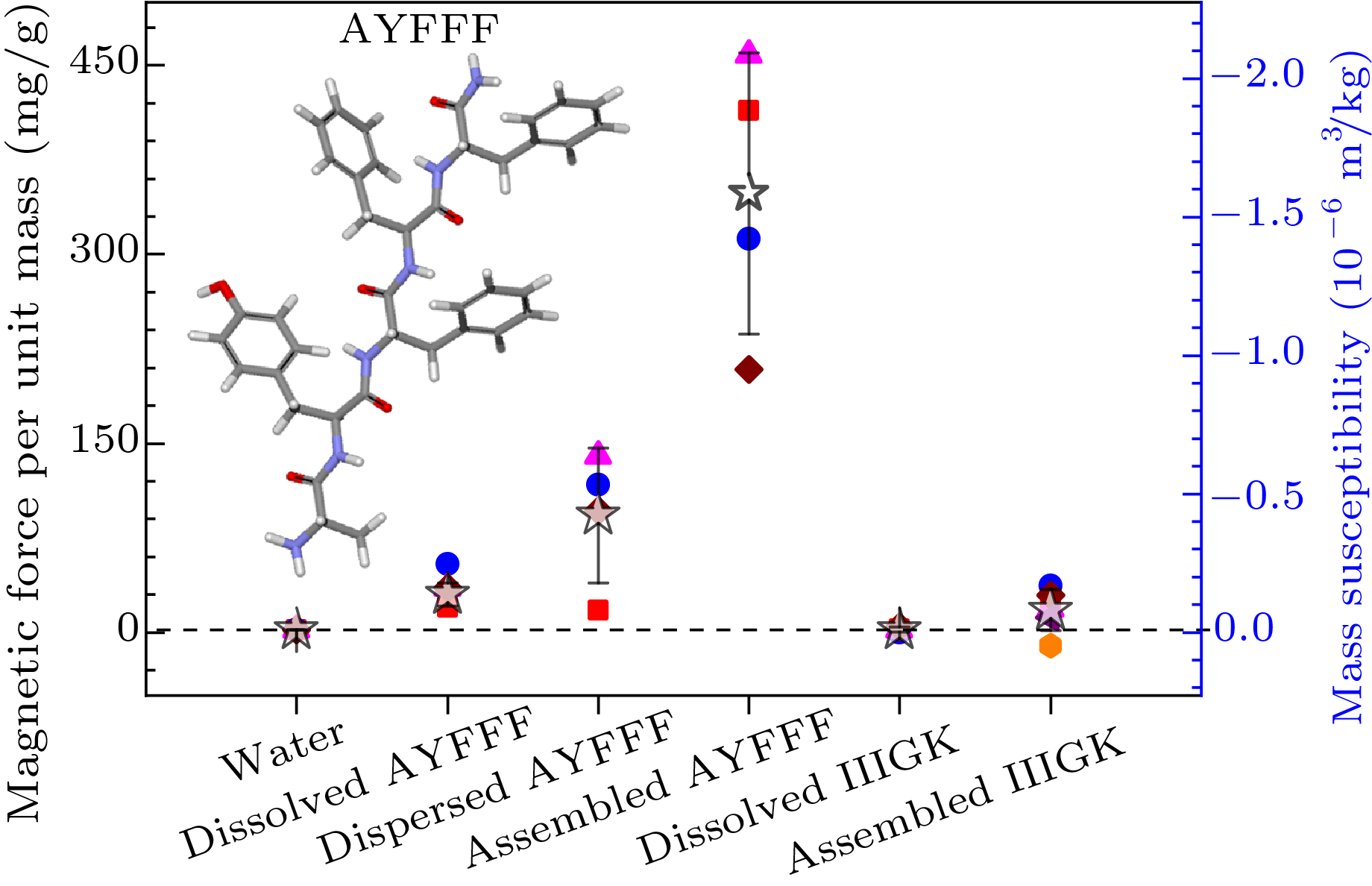| CONDENSED MATTER: ELECTRONIC STRUCTURE, ELECTRICAL, MAGNETIC, AND OPTICAL PROPERTIES |
 |
|

|
|
|
Unexpectedly Strong Diamagnetism of Self-Assembled Aromatic Peptides |
| Haijun Yang1,2, Zixin Wang3, Liuhua Mu2, Yongshun Song4, Jun Hu1, Feng Zhang3,5*, and Haiping Fang4,1* |
1Shanghai Synchrotron Radiation Facility, Zhangjiang Laboratory (SSRF, ZJLab), Shanghai Advanced Research Institute, Chinese Academy of Sciences, Shanghai 201204, China
2Division of Interfacial Water, CAS Key Laboratory of Interfacial Physics and Technology, Shanghai Institute of Applied Physics, Chinese Academy of Sciences, Shanghai 201800, China
3State Key Laboratory of Respiratory Disease, Guangzhou Institute of Oral Disease, Stomatology Hospital, Department of Biomedical Engineering, School of Basic Medical Sciences, Guangzhou Medical University, Guangzhou 511436, China
4School of Science, East China University of Science and Technology, Shanghai 200237, China
5Biomedical Nanocenter, School of Life Science, Inner Mongolia Agricultural University, Hohhot 010011, China
|
|
| Cite this article: |
|
Haijun Yang, Zixin Wang, Liuhua Mu et al 2020 Chin. Phys. Lett. 37 087504 |
|
|
|
|
Abstract There is a considerable amount of work that shows the biomagnetism of organic components without ferromagnetic components at the molecular level, but it is of great challenge to cover the giant gap of biomagnetism between their experimental and theoretical results. Here we show that the diamagnetism of aromatic peptides is greatly enhanced for about 11 times by self-assembling, reaching two orders of magnitude higher than the mass susceptibility of pure water. The self-assembly of aromatic rings in the peptide molecules plays the key role in such a strong diamagnetism.
|
|
Received: 28 June 2020
Published: 09 July 2020

|
|
| PACS: |
75.90.+w
|
(Other topics in magnetic properties and materials)
|
| |
87.90.+y
|
(Other topics in biological and medical physics)
|
| |
87.14.ef
|
(Peptides)
|
|
|
| Fund: Supported by the National Natural Science Foundation of China (Grant Nos. U1632135, 11974366, U1932123, 51763019 and U1832125), the Key Research Program of Chinese Academy of Sciences (Grant No. QYZDJ-SSW-SLH053), and the Fundamental Research Funds for the Central Universities. |
|
|
|
| [1] | Crease R 1989 Science 245 1041 |
| [2] | Hobbie R K and Roth B J 2007 Intermediate Physics for Medicine and Biology (New York: Springer) p 203 |
| [3] | Lorant S J S 1977 Biomagnetism: A Review pSLAC-PUB-1984 |
| [4] | Tao Q, Zhang L, Han X, Chen H, Ji X and Zhang X 2020 Biophys. J. 118 578 |
| [5] | A Hill R J, Sedman V L, Allen S, Williams P, Paoli M, Adler-Abramovich L, Gazit E, Eaves L and Tendler S J B 2007 Adv. Mater. 19 4474 |
| [6] | Kwon S, Kim B J, Lim H K, Kang K, Yoo S H, Gong J, Yoon E, Lee J, Choi I S, Kim H and Lee H S 2015 Nat. Commun. 6 8747 |
| [7] | Pauling L 1979 Proc. Natl. Acad. Sci. USA 76 2293 |
| [8] | Worcester D L 1978 Proc. Natl. Acad. Sci. USA 75 5475 |
| [9] | Nakamae S, Cazayous M, Sacuto A, Monod P and Bouchiat H 2005 Phys. Rev. Lett. 94 248102 |
| [10] | Nanni G, Petroni S, Fragouli D, Amato M, De Vittorio M and Athanassiou A 2012 Microelectron. Eng. 98 607 |
| [11] | Gong N J, Dibb R, Bulk M, van der Weerd L and Liu C 2019 NeuroImage 191 176 |
| [12] | Jones K M, Pollard A C and Pagel M D 2018 J. Magn. Reson. Imaging 47 11 |
| [13] | Abdulkader S N, Atia A and Mostafa M S M 2015 Egypt. Inf. J. 16 213 |
|
|
Viewed |
|
|
|
Full text
|
|
|
|
|
Abstract
|
|
|
|
|